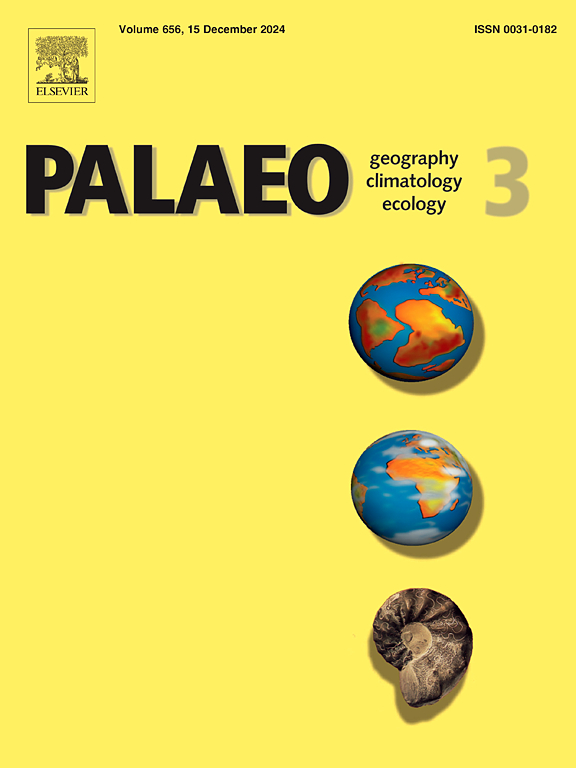中元古代海洋氧化的mo同位素约束:来自华北克拉通~ 1.64 Ga川岭沟组黑色页岩的启示
IF 2.7
2区 地球科学
Q2 GEOGRAPHY, PHYSICAL
Palaeogeography, Palaeoclimatology, Palaeoecology
Pub Date : 2025-05-30
DOI:10.1016/j.palaeo.2025.113077
引用次数: 0
摘要
氧气是地球上生命进化的关键驱动力。目前的观点认为,中元古代存在持续的低氧水平,而更多的证据表明,这一时期存在间歇性的氧合事件,与显著的生物进化事件相匹配。华北克拉通东部~ 1.64 Ga川岭沟组提供了保存完好的最早的多细胞真核生物化石记录,也是自晚斯塔世以来第一次大规模黑色页岩的出现。这与同时期广泛分布于不同克拉通的黑色页岩有关,反映了与哥伦比亚超大陆裂陷有关的全球性地质事件。然而,当时海洋系统的氧化还原条件尚不清楚。本研究主要利用川岭沟黑色页岩的钼(Mo)浓度、Mo同位素组成(δ98/95Mo)和氧化还原敏感微量元素(RSE,如Mo、U、V)等多指标地球化学数据来量化沉积过程中海水的氧化还原状态。样品全岩Mo浓度范围为0.19 ppm ~ 1.47 ppm, δ98/95Mo浓度范围为−0.01‰~ +1.42‰。该层序上部Mo浓度异常高(4.09 ppm), δ98/95Mo值异常高(1.01‰),总有机碳含量异常高(TOC = 2.17%), MoEF、VEF和UEF富集系数异常高(3.91),VEF和UEF分别为0.88和1.35。这代表了一种最接近缺氧状态的氧化还原条件,这可能意味着风化作用的增强。Mo同位素质量平衡模型表明,最小的海底氧化面积为~ 38%。或者,最大氧系统可以限制在~ 45%。在裂谷火山作用增强、氧化风化作用增强和容纳空间扩大的综合作用下,营养通量增加,导致中元古代早期发生了短暂的氧合作用事件。这可能为当时真核生物的标志性进化提供了有利的环境条件。本文章由计算机程序翻译,如有差异,请以英文原文为准。
Mo-isotope constraints on the mid-Proterozoic ocean oxidation: Insights from the black shales of the ∼1.64 Ga Chuanlinggou Formation, North China Craton
Oxygen is a critical driver in the evolution of life on Earth. Current views suggest a persistently low oxygen level during the mid-Proterozoic, while more evidence points to episodic oxygenation events in this period, matching with remarkable biological evolution events. The ∼1.64 Ga Chuanlinggou Formation in the eastern North China Craton (NCC) offers a well-preserved fossil record of the earliest multicellular eukaryotes, and the first large-scale black shale occurrence since the late Statherian. This is correlated with contemporaneous black shales widely distributed in different cratons, reflecting a global geological event linked to the rifting of Columbia supercontinent. However, the redox conditions of the ocean system at that time remain unclear. In this study, we mostly present a multi-proxy geochemical dataset of the Chuanlinggou black shales, including molybdenum (Mo) concentration, Mo isotopic composition (δ98/95Mo), and redox-sensitive trace elements (RSE, e.g., Mo, U, V), to quantify the redox state of the seawater during sedimentation. The whole-rock Mo concentrations of samples range from 0.19 ppm to 1.47 ppm and δ98/95Mo from −0.01 ‰ to +1.42 ‰. An anomalous high Mo concentration (4.09 ppm) and high δ98/95Mo (1.01 ‰) values were observed in the upper part of this sequence, corresponding with the high total organic carbon contents (TOC = 2.17 %) and enrichment factors of high MoEF (3.91), VEF (0.88) and UEF (1.35). This represents a redox condition closest to the euxinic state, which may imply an enhanced weathering effect. The Mo isotope mass balance modeling suggests a minimum seafloor oxidation area of ∼38 %. Alternatively, the maximum euxinic system could be limited to ∼45 %. We infer a short-lived oxygenation event during the early mid-Proterozoic, driven by increased nutrient fluxes resulting from the comprehensive effects of intensified rift volcanism, enhanced oxidative weathering and expanded accommodation space. It may have provided favorable environmental conditions for the landmark evolution of eukaryotes during that time.
求助全文
通过发布文献求助,成功后即可免费获取论文全文。
去求助
来源期刊
CiteScore
5.90
自引率
10.00%
发文量
398
审稿时长
3.8 months
期刊介绍:
Palaeogeography, Palaeoclimatology, Palaeoecology is an international medium for the publication of high quality and multidisciplinary, original studies and comprehensive reviews in the field of palaeo-environmental geology. The journal aims at bringing together data with global implications from research in the many different disciplines involved in palaeo-environmental investigations.
By cutting across the boundaries of established sciences, it provides an interdisciplinary forum where issues of general interest can be discussed.

 求助内容:
求助内容: 应助结果提醒方式:
应助结果提醒方式:


